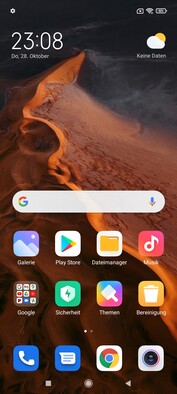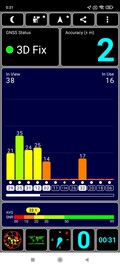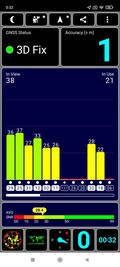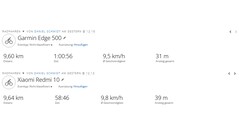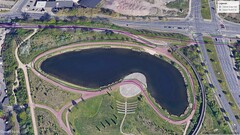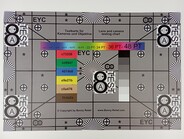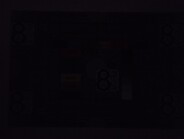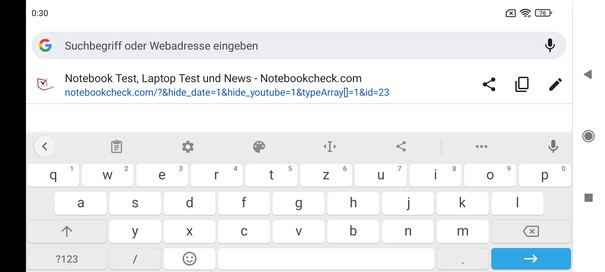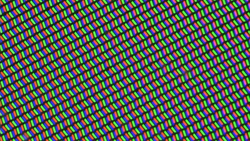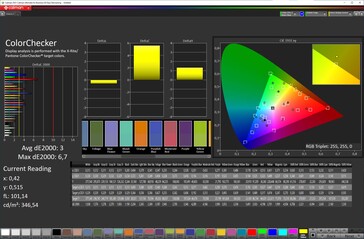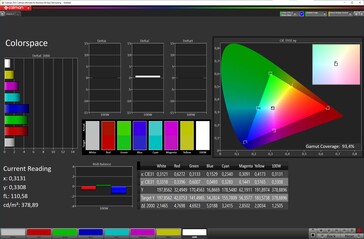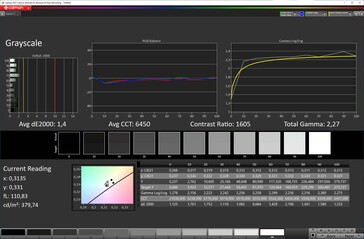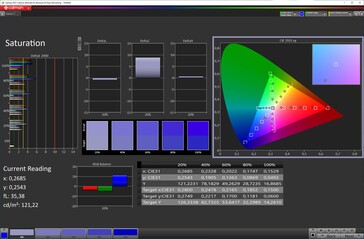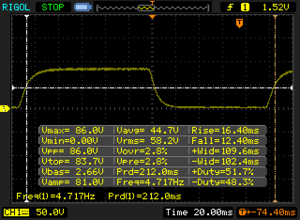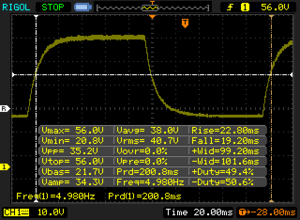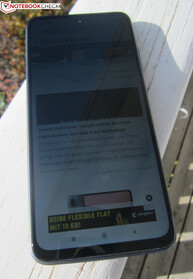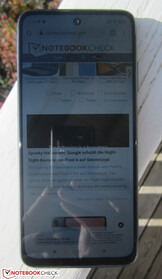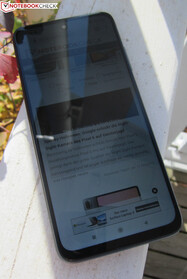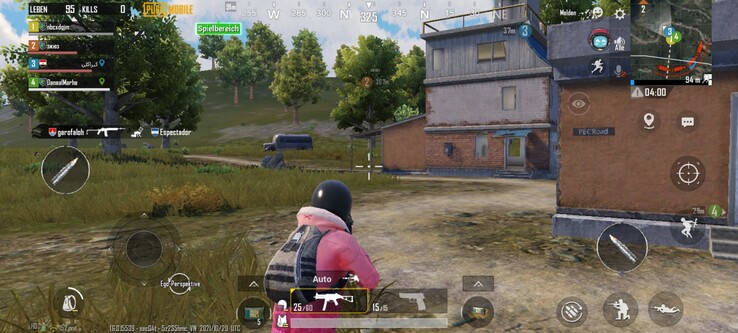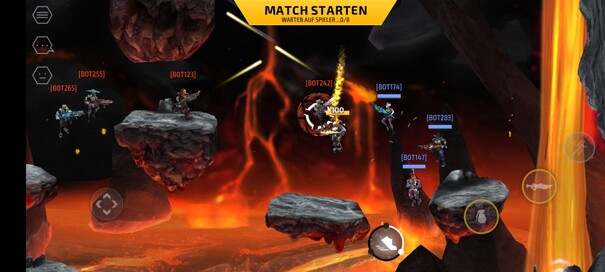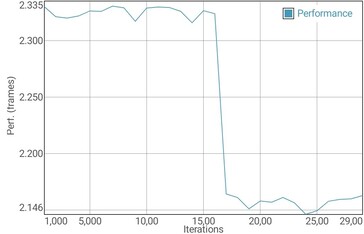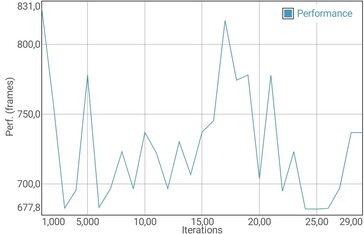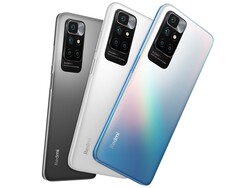Xiaomi Redmi 10 smartphone review: Good budget phone with NFC and 90 Hz
Xiaomi is being very competitive with the Redmi 10, because the 6.5-inch smartphone can be purchased for less than 200 Euros (~$231). The Redmi 9's successor has a solid configuration with the MediaTek Helio G88, 4 GB of RAM, up to 128 GB of storage, and a 5,000 mAh battery that supports 18-watt fast charging. We reviewed the 64 GB version, which is offered by Xiaomi in its online store for around 180 Euros (~$208).
The Redmi 10 doesn't support 5G, but it offers two features that want to set the smartphone apart from the masses: A 50 MP main camera and a refresh rate of 90 Hz. However, these aren't unique selling points in the low-budget segment, which is why Xiaomi has to compete with strong rivals right from the start. Read on to find out how it performs in the test.
Possible contenders in comparison
Rating | Date | Model | Weight | Drive | Size | Resolution | Price |
|---|---|---|---|---|---|---|---|
| 79 % v7 (old) | 11 / 2021 | Xiaomi Redmi 10 Helio G88, Mali-G52 MP2 | 181 g | 64 GB eMMC Flash | 6.50" | 2400x1080 | |
| 79.2 % v7 (old) | 07 / 2021 | Motorola Moto G50 SD 480, Adreno 619 | 192 g | 64 GB UFS 2.1 Flash | 6.50" | 1600x720 | |
| 76.4 % v7 (old) | 07 / 2021 | Nokia G20 Helio G35, PowerVR GE8320 | 197 g | 64 GB eMMC Flash | 6.50" | 1600x720 | |
| 77 % v7 (old) | 11 / 2021 | Oppo A16s Helio G35, PowerVR GE8320 | 190 g | 64 GB eMMC Flash | 6.52" | 1600x720 | |
| 79.6 % v7 (old) | 08 / 2021 | Samsung Galaxy A22 5G Dimensity 700, Mali-G57 MP2 | 203 g | 64 GB eMMC Flash | 6.60" | 2400x1080 |
Case - Gorilla Glass 3 for the Redmi 10
The case of the Redmi 10 is made of plastic, but it's very well built and has a higher-quality look and feel than its price would suggest. Stability is also good, since the smartphone withstood twisting attempts without a sound in the test. Only the back cover can be slightly pressed in at the center. However, none of this reaches the display, because no image artifacts are caused.
The front of the Redmi 10 is protected by a layer of Gorilla Glass 3, and it houses an 8 MP selfie camera in a punch hole. The back cover is not very susceptible to fingerprints thanks to its matte surface finish. At the same time, it offers fingers a slight resistance, so that the smartphone can be held quite securely in the hand even without a protective case.
At 181 grams, the Xiaomi weighs slightly less than many competitors that feature the same form factor. The Redmi 9 predecessor is noticeably heavier at 198 grams. Because the quad-camera setup with its 50 MP main camera protrudes a few millimeters from the back cover, it's recommended to put the smartphone in the included transparent case, because it will otherwise wobble quite a bit when placed on a table.
The Xiaomi Redmi 10 is available in three color variants: Carbon Gray, Pebble White, and Sea Blue. It does not have an IP certification.
Connectivity - 3.5 mm audio jack, NFC, and real dual-SIM functionality
Xiaomi offers the Redmi 10 in two storage variants. With 4 GB LPDDR4x RAM and 64 GB of eMMC 5.1 flash storage, it costs around 180 Euros (~$208) in Xiaomi's online store. The larger storage variant of the 4G smartphone comes with 128 GB and costs 200 Euros (~$231).
With NFC, a 3.5 mm audio jack, an IR blaster, and dual SIM, you get a solid configuration. The card slot can simultaneously accommodate two nano SIM cards and a microSD card of up to 512 GB. The USB-C port operates at USB 2.0 speeds.
microSD card reader
The microSD card slot is fast for the price range, and it ranks pretty far ahead among the comparison devices in the copy test. The Xiaomi device also performs well in sequential reading and writing using our reference Angelbird AV Pro V60 memory card.
| SD Card Reader - average JPG Copy Test (av. of 3 runs) | |
| Oppo A16s (Angelbird AV Pro V60) | |
| Samsung Galaxy A22 5G (Angelbird V60) | |
| Xiaomi Redmi 10 (Angelbird AV Pro V60) | |
| Nokia G20 (Angelbird V60) | |
| Motorola Moto G50 (Angelbird V60) | |
Cross Platform Disk Test (CPDT)
Software - Android 11 and MIUI 12.5
The Xiaomi Redmi 10 runs Android 11 and Xiaomi's MIUI 12.5 user interface. During our review period, the smartphone received an update that brought its Android security patches to the level of October 1, which is very up to date.
Out of the 64 GB of our review sample, only about 42 GB of storage space was still available after resetting the device, but this can be quite sufficient depending on the type of use. Those who need more space can delete the few preinstalled third-party apps like AliExpress and TikTok. App data can't be stored on the microSD card.
Communication and GNSS - Fast Wi-Fi, accurate GPS
The Xiaomi Redmi 10 supports Bluetooth 5.1 as well as NFC, making it suitable for mobile payments. It provides solid mobile coverage with 12 LTE frequencies, but it's not a smartphone for globetrotters. However, the majority of frequencies relevant for the EU region are supported.
In terms of WLAN, the smartphone communicates via Wi-Fi 5. In combination with our Linksys Nighthawk AX12 reference router, it also achieves the corresponding transfer rates and manages up to 333 Mb/s. Good: Data transfers are very stable both when sending and receiving data.
| Networking | |
| iperf3 transmit AX12 | |
| Samsung Galaxy A22 5G | |
| Motorola Moto G50 | |
| Oppo A16s | |
| Xiaomi Redmi 10 | |
| Nokia G20 | |
| iperf3 receive AX12 | |
| Samsung Galaxy A22 5G | |
| Xiaomi Redmi 10 | |
| Motorola Moto G50 | |
| Oppo A16s | |
| Nokia G20 | |
GPS (L1), GLONASS (L1), Galileo (E1) and BeiDou (B1) are the satellite navigation systems that the Redmi 10 uses to determine its current position. This works very quickly in the test, both indoors and outdoors, and an accuracy of up to one meter is achieved.
Accuracy remains high even in motion, making the Redmi 10 a very good navigation device when you're on the move. The Xiaomi smartphone tracked the route almost as accurately as the Garmin Edge 500 professional navigation device on a nearly 10-kilometer long test route.
Telephone and call quality - VoLTE and VoWiFi
The Redmi 10 performs solidly in terms of call quality. Voices sound natural, and they remain intelligible in both directions even in hands-free mode. Phone calls can also be made via VoLTE and VoWiFi, provided that the network provider supports it.
Cameras - Quad-camera setup with 50 MP
The Xiaomi Redmi 10 is equipped with a quad-camera setup that takes up a lot of space on the back cover, making it look quite important. Unfortunately, the reality is somewhat different. The centerpiece of the quad-camera setup is the 50 MP main camera (f/1.8), which combines four neighboring pixels into one via pixel-binning and therefore takes 12.5 MP photos. However, you can also shoot with the full 50 MP in the "50M" mode.
As long as there's enough light, the main camera takes reasonably sharp and detailed pictures. However, they often lack a good amount of dynamics, which often makes the photographed colors look dull. The camera doesn't do a particularly good job with zoom shots, either. You can still get some details out of the subjects in low ambient light using Night Mode, but the overall low-light performance is weak. Due to the lack of image stabilization, videos are pretty shaky and, like with the selfie camera, they are limited to 1080p at 30 frames per second.
The uppermost and largest lens in the camera ensemble is an 8 MP wide-angle camera (f/2.2). It covers a 120° field of view and is activated as soon as you set the zoom factor to 0.5x. If a video is being recorded, however, it's no longer possible to switch between the two lenses. The wide-angle camera uses a slightly different white balance than the main camera and leaves us with a slightly better impression than the main camera. It takes solid pictures and doesn't distort at the edges of the picture as much as some other smartphone lenses.
The third and fourth cameras, the macro camera and the depth sensor, are rather superfluous. The latter because it only serves to create blur effects. And the macro camera, which can be activated in the photo options, can simply be left aside, since the digital zoom produces results that are at least as good.
Image comparison
Choose a scene and navigate within the first image. One click changes the position on touchscreens. One click on the zoomed-in image opens the original in a new window. The first image shows the scaled photograph of the test device.
Daylight-Scene 1Daylight-Scene 2Ultra-wide angle5x zoomLow-light photoUnder controlled lighting conditions, the main camera is certainly able to reproduce colors accurately, so that better quality photos should be possible through software optimizations. However, low ambient light (lower color chart at 1 lux) overstrains both the camera and the software. The camera can only capture dark gray tones more or less accurately. Furthermore, the test chart, which looked sharp in optimal lighting conditions, is only dimly visible here.
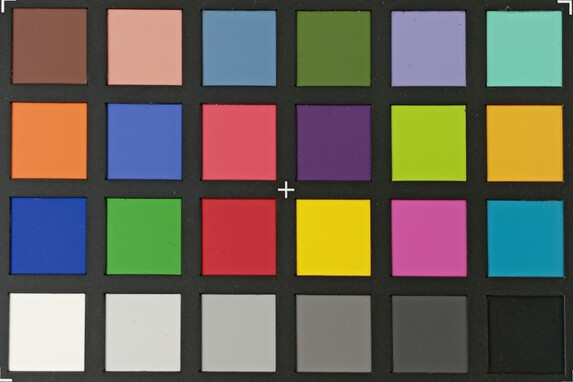
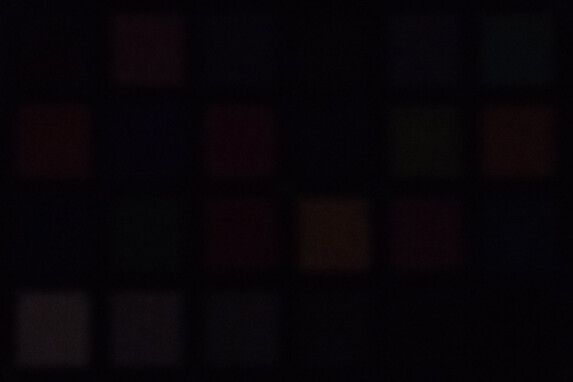
Accessories and warranty - Protective case included
Xiaomi includes a 22.5-watt power adapter with the Redmi 10, even though the smartphone can only be charged at a maximum of 18 watts. The box also contains a USB-C cable (Type-C to A), a SIM tool, a transparent protective case, a Quick Start guide, and a warranty card.
The Xiaomi Redmi 10 comes with a 12-month warranty.
Input devices and handling - 90 Hz display and a fast fingerprint scanner
The touchscreen can be used smoothly due to its 90 Hz refresh rate. The panel will also adapt automatically to the content being displayed. For example, the display is set to 45 Hz when a static image is shown, while 60 Hz is used for video streaming, and the full 90 Hz is used for gaming or scrolling.
The Redmi 10 can be unlocked biometrically in two ways. The first is with the fingerprint sensor that is integrated into the power button, which works quickly and reliably. The second method is the less secure 2D face scan, which delivers equally good authentication results in good ambient light.
Display - IPS panel with 1080p resolution
The Xiaomi Redmi 10's 6.5-inch IPS display has a resolution of 2400x1080 pixels (Full HD+) and a pixel density of 405 PPI. The display doesn't support HDR, but it doesn't come with pulse width modulation (PWM), either, which is good news. Since the IPS panel controls its brightness without the help of PWM, the Redmi 10 is also perfectly suited for users with sensitive eyes, who would otherwise be bothered by this effect.
The IPS panel achieves a good brightness of 518 cd/m² on average. With evenly distributed bright and dark image areas (APL50) instead of a pure white background, the brightness reaches up to 535 cd/m². The Redmi 10 achieves a maximum of 439 cd/m² when the brightness sensor is not enabled. At the lowest brightness setting, we measure 1.34 cd/m².
| |||||||||||||||||||||||||
Brightness Distribution: 93 %
Center on Battery: 542 cd/m²
Contrast: 2464:1 (Black: 0.22 cd/m²)
ΔE ColorChecker Calman: 3 | ∀{0.5-29.43 Ø4.78}
ΔE Greyscale Calman: 1.4 | ∀{0.09-98 Ø5}
93.4% sRGB (Calman 2D)
Gamma: 2.27
CCT: 6450 K
| Xiaomi Redmi 10 IPS, 2400x1080, 6.5" | Motorola Moto G50 IPS, 1600x720, 6.5" | Nokia G20 IPS, 1600x720, 6.5" | Oppo A16s LCD, 1600x720, 6.5" | Samsung Galaxy A22 5G IPS, 2400x1080, 6.6" | |
|---|---|---|---|---|---|
| Screen | -41% | -80% | -27% | -61% | |
| Brightness middle (cd/m²) | 542 | 340 -37% | 485 -11% | 607 12% | 415 -23% |
| Brightness (cd/m²) | 518 | 325 -37% | 447 -14% | 586 13% | 378 -27% |
| Brightness Distribution (%) | 93 | 92 -1% | 88 -5% | 90 -3% | 76 -18% |
| Black Level * (cd/m²) | 0.22 | 0.18 18% | 0.44 -100% | 0.52 -136% | 0.26 -18% |
| Contrast (:1) | 2464 | 1889 -23% | 1102 -55% | 1167 -53% | 1596 -35% |
| Colorchecker dE 2000 * | 3 | 4.75 -58% | 5.75 -92% | 3.1 -3% | 5.41 -80% |
| Colorchecker dE 2000 max. * | 6.7 | 7.53 -12% | 10.53 -57% | 6.7 -0% | 9.77 -46% |
| Greyscale dE 2000 * | 1.4 | 3.9 -179% | 5.7 -307% | 2 -43% | 4.8 -243% |
| Gamma | 2.27 97% | 2.224 99% | 2.095 105% | 2.17 101% | 2.348 94% |
| CCT | 6450 101% | 7384 88% | 8070 81% | 6806 96% | 7748 84% |
* ... smaller is better
Screen Flickering / PWM (Pulse-Width Modulation)
| Screen flickering / PWM not detected | |||
In comparison: 53 % of all tested devices do not use PWM to dim the display. If PWM was detected, an average of 8111 (minimum: 5 - maximum: 343500) Hz was measured. | |||
The color reproduction of the Redmi 10 can be adjusted using three modes: "Vivid", "Saturated", and "Standard". In addition, the color temperature can be adjusted using a color wheel or the three presets "Standard", "Warm", and "Cool".
We get the most accurate color reproduction using the "Vivid" and "Warm" settings. In this case, the DeltaE deviations for colors and grayscales are within the ideal range (DeltaE ≤ 3), just like the color temperature of 6,450 K. The IPS panel also treats viewers with rich contrasts thanks to its low black level.
Display Response Times
| ↔ Response Time Black to White | ||
|---|---|---|
| 28.8 ms ... rise ↗ and fall ↘ combined | ↗ 16.4 ms rise | |
| ↘ 12.4 ms fall | ||
| The screen shows relatively slow response rates in our tests and may be too slow for gamers. In comparison, all tested devices range from 0.1 (minimum) to 240 (maximum) ms. » 75 % of all devices are better. This means that the measured response time is worse than the average of all tested devices (20.2 ms). | ||
| ↔ Response Time 50% Grey to 80% Grey | ||
| 42 ms ... rise ↗ and fall ↘ combined | ↗ 22.8 ms rise | |
| ↘ 19.2 ms fall | ||
| The screen shows slow response rates in our tests and will be unsatisfactory for gamers. In comparison, all tested devices range from 0.165 (minimum) to 636 (maximum) ms. » 66 % of all devices are better. This means that the measured response time is worse than the average of all tested devices (31.6 ms). | ||
Since the Xiaomi offers quite a bit of brightness, it should actually be easy to use outdoors. However, the IPS panel's viewing-angle stability, which is not very good, poses a few challenges for outdoor use. The smartphone should be held as perpendicular to the viewing direction as possible, because even tilting the screen by about 45° is enough for the display to become noticeably darker. However, the panel doesn't darken any further at flatter viewing angles.
Performance - Solid everyday performance with the MediaTek Helio G88
The Xiaomi Redmi 10 is powered by the mid-range MediaTek Helio G88 SoC. The octa-core CPU is manufactured in a 12 nm size, and it uses two fast ARM Cortex-A75 performance cores that run at up to 2 GHz. This is accompanied by six ARM Cortex-A55 power-saving cores (max 1.8 GHz). The ARM Mali-G52 serves as the GPU.
The MediaTek SoC is supported by 4 GB of LPDDR4x RAM, which makes for a largely smooth everyday performance. However, minor delays can occasionally occur in the otherwise smoothly animated MIUI during multitasking.
Our review shows that the Redmi 10 is one of the faster budget smartphones with its MediaTek Helio G88. There's no way to beat the Motorola Moto G50 with its Snapdragon 480 5G, but the Nokia G20 and the Oppo A16s, which are both equipped with the MediaTek Helio G35, are clearly beaten by the Xiaomi phone.
The Redmi 10 is just as fast in the synthetic benchmarks as its predecessor, the Redmi 9, which even scores slightly better in the browser benchmarks at times. However, this isn't noticeable in terms of browsing speeds. Websites load quickly and can be scrolled through briskly.
| GFXBench (DX / GLBenchmark) 2.7 | |
| T-Rex Onscreen (sort by value) | |
| Xiaomi Redmi 10 | |
| Motorola Moto G50 | |
| Samsung Galaxy A22 5G | |
| Average Mediatek Helio G88 (34 - 42, n=5) | |
| Average of class Smartphone (12 - 166, n=157, last 2 years) | |
| 1920x1080 T-Rex Offscreen (sort by value) | |
| Xiaomi Redmi 10 | |
| Motorola Moto G50 | |
| Samsung Galaxy A22 5G | |
| Average Mediatek Helio G88 (38 - 46, n=5) | |
| Average of class Smartphone (22 - 954, n=157, last 2 years) | |
| GFXBench 3.0 | |
| on screen Manhattan Onscreen OGL (sort by value) | |
| Xiaomi Redmi 10 | |
| Motorola Moto G50 | |
| Samsung Galaxy A22 5G | |
| Average Mediatek Helio G88 (18 - 24, n=5) | |
| Average of class Smartphone (18 - 166, n=159, last 2 years) | |
| 1920x1080 1080p Manhattan Offscreen (sort by value) | |
| Xiaomi Redmi 10 | |
| Motorola Moto G50 | |
| Samsung Galaxy A22 5G | |
| Average Mediatek Helio G88 (21 - 26, n=5) | |
| Average of class Smartphone (12 - 606, n=157, last 2 years) | |
| GFXBench 3.1 | |
| on screen Manhattan ES 3.1 Onscreen (sort by value) | |
| Xiaomi Redmi 10 | |
| Motorola Moto G50 | |
| Samsung Galaxy A22 5G | |
| Average Mediatek Helio G88 (13 - 15, n=5) | |
| Average of class Smartphone (11 - 166, n=158, last 2 years) | |
| 1920x1080 Manhattan ES 3.1 Offscreen (sort by value) | |
| Xiaomi Redmi 10 | |
| Motorola Moto G50 | |
| Samsung Galaxy A22 5G | |
| Average Mediatek Helio G88 (13 - 16, n=5) | |
| Average of class Smartphone (8.4 - 413, n=158, last 2 years) | |
| Antutu v9 - Total Score (sort by value) | |
| Motorola Moto G50 | |
| Samsung Galaxy A22 5G | |
| Average Mediatek Helio G88 (259233 - 272388, n=2) | |
| Average of class Smartphone (99654 - 2056989, n=29, last 2 years) | |
| AnTuTu v8 - Total Score (sort by value) | |
| Xiaomi Redmi 10 | |
| Motorola Moto G50 | |
| Samsung Galaxy A22 5G | |
| Average Mediatek Helio G88 (n=1) | |
| VRMark - Amber Room (sort by value) | |
| Xiaomi Redmi 10 | |
| Xiaomi Redmi 9 | |
| Average Mediatek Helio G88 (n=1) | |
| AImark - Score v2.x (sort by value) | |
| Xiaomi Redmi 10 | |
| Motorola Moto G50 | |
| Samsung Galaxy A22 5G | |
| Average Mediatek Helio G88 (n=1) | |
| Jetstream 2 - 2.0 Total Score | |
| Average of class Smartphone (23.8 - 387, n=154, last 2 years) | |
| Motorola Moto G50 (Chrome 91) | |
| Samsung Galaxy A22 5G (Chrome 92) | |
| Average Mediatek Helio G88 (28.1 - 48, n=4) | |
| Xiaomi Redmi 9 (Chrome 85) | |
| Xiaomi Redmi 10 (Chrome 94.0.4606.85) | |
| JetStream 1.1 - Total Score | |
| Motorola Moto G50 (Chrome 91) | |
| Samsung Galaxy A22 5G (Chrome 92) | |
| Xiaomi Redmi 9 (Chrome 85) | |
| Xiaomi Redmi 10 (Chrome 94.0.4606.85) | |
| Average Mediatek Helio G88 (n=1) | |
| Speedometer 2.0 - Result 2.0 | |
| Average of class Smartphone (15.2 - 643, n=128, last 2 years) | |
| Motorola Moto G50 (Chome 91) | |
| Samsung Galaxy A22 5G (Chome 92) | |
| Xiaomi Redmi 9 (Chrome 85) | |
| Xiaomi Redmi 10 (Chrome 94.0.4606.85) | |
| Average Mediatek Helio G88 (20.6 - 27.5, n=3) | |
| WebXPRT 3 - Overall | |
| Average of class Smartphone (38 - 380, n=35, last 2 years) | |
| Motorola Moto G50 (Chrome 91) | |
| Samsung Galaxy A22 5G (Chrome 92) | |
| Xiaomi Redmi 10 (Chrome 94.0.4606.85) | |
| Average Mediatek Helio G88 (43 - 53, n=3) | |
| Xiaomi Redmi 9 | |
| Octane V2 - Total Score | |
| Average of class Smartphone (2228 - 121337, n=201, last 2 years) | |
| Samsung Galaxy A22 5G (Chrome 92) | |
| Motorola Moto G50 (Chrome 91) | |
| Average Mediatek Helio G88 (7611 - 15102, n=7) | |
| Xiaomi Redmi 10 (Chrome 94.0.4606.85) | |
| Xiaomi Redmi 9 (Chrome 85) | |
| Mozilla Kraken 1.1 - Total | |
| Average Mediatek Helio G88 (2743 - 5573, n=4) | |
| Xiaomi Redmi 9 (Chrome 85) | |
| Xiaomi Redmi 10 (Chrome 94.0.4606.85) | |
| Motorola Moto G50 (Chrome 91) | |
| Samsung Galaxy A22 5G (Chrome 92) | |
| Average of class Smartphone (257 - 28190, n=156, last 2 years) | |
* ... smaller is better
The Redmi 10 uses a very fast type of eMMC storage for its smartphone class, which makes it have the shortest load times by far among the comparison devices. It's only surpassed by the Motorola Moto G50.
| Xiaomi Redmi 10 | Motorola Moto G50 | Nokia G20 | Oppo A16s | Samsung Galaxy A22 5G | Xiaomi Redmi 9 | Average 64 GB eMMC Flash | Average of class Smartphone | |
|---|---|---|---|---|---|---|---|---|
| AndroBench 3-5 | 16% | -38% | -33% | 0% | -33% | -30% | 492% | |
| Sequential Read 256KB (MB/s) | 321.3 | 392 22% | 256.1 -20% | 289.2 -10% | 300.5 -6% | 289.9 -10% | 277 ? -14% | 2223 ? 592% |
| Sequential Write 256KB (MB/s) | 178 | 204.4 15% | 139.3 -22% | 168.4 -5% | 210.3 18% | 119.8 -33% | 178.4 ? 0% | 1838 ? 933% |
| Random Read 4KB (MB/s) | 100.7 | 89.2 -11% | 63.5 -37% | 45.32 -55% | 118 17% | 49.09 -51% | 60.7 ? -40% | 295 ? 193% |
| Random Write 4KB (MB/s) | 95.8 | 131.7 37% | 27.4 -71% | 35.23 -63% | 69.2 -28% | 60.7 -37% | 33.8 ? -65% | 335 ? 250% |
Games - The 90 Hz display doesn't provide any advantages
The Xiaomi Redmi 10 runs games quite smoothly, and it accompanies them with stereo sound, but it can hardly take advantage of its 90 Hz display. Only in graphically very simple games like Subway Surfers is 60 frames per second possible. The fact that there are still brief drops in frame rates here shows that the hardware is more or less already working at its limit. The FPS limit is even much lower in graphically demanding games like PUBG Mobile. The Redmi 10 still manages to display the popular shooter at a practically constant 30 FPS even in the HD/High setting.
We determined the frame rates with the Gamebench tool.
Emissions - Stereo speakers as trump card
Temperature
The Redmi 10 produces much less waste heat than its predecessor, the Redmi 9. It only heats up to a maximum of 35.8 °C (~96 °F) during use (Redmi 9: 44.8 °C (~112 °F)); therefore, it only gets warm to the touch at most.
Even under continuous load, the smartphone hardly has to throttle its performance. We only observe a slightly higher degree of throttling in the GFXBench stress tests.
(+) The maximum temperature on the upper side is 35.8 °C / 96 F, compared to the average of 35.2 °C / 95 F, ranging from 21.9 to 247 °C for the class Smartphone.
(+) The bottom heats up to a maximum of 35.8 °C / 96 F, compared to the average of 34 °C / 93 F
(+) In idle usage, the average temperature for the upper side is 30.5 °C / 87 F, compared to the device average of 32.9 °C / 91 F.
3DMark Wild Life Stress Test
| 3DMark | |
| Wild Life Stress Test Stability | |
| Samsung Galaxy A22 5G | |
| Xiaomi Redmi 10 | |
| Wild Life Extreme Stress Test | |
| Xiaomi Redmi 10 | |
| Samsung Galaxy A22 5G | |
Speakers
The Redmi 10 has a little ace up its sleeve with its stereo speakers, since producing sound from two sides is rather the exception and not the rule in low-budget smartphones. For example, the Motorola Moto G50 and the Samsung Galaxy A22 5G only have mono sound. However, the Redmi 10's two speakers aren't particularly powerful, which is due to the practically nonexistent bass.
External audio devices can be connected via Bluetooth 5.1 and a 3.5 mm audio jack.
Xiaomi Redmi 10 audio analysis
(+) | speakers can play relatively loud (88.9 dB)
Bass 100 - 315 Hz
(-) | nearly no bass - on average 33% lower than median
(±) | linearity of bass is average (9.2% delta to prev. frequency)
Mids 400 - 2000 Hz
(+) | balanced mids - only 3.3% away from median
(+) | mids are linear (4.6% delta to prev. frequency)
Highs 2 - 16 kHz
(+) | balanced highs - only 4.1% away from median
(+) | highs are linear (3.7% delta to prev. frequency)
Overall 100 - 16.000 Hz
(±) | linearity of overall sound is average (19.8% difference to median)
Compared to same class
» 30% of all tested devices in this class were better, 8% similar, 62% worse
» The best had a delta of 11%, average was 35%, worst was 134%
Compared to all devices tested
» 49% of all tested devices were better, 7% similar, 43% worse
» The best had a delta of 4%, average was 24%, worst was 134%
Samsung Galaxy A22 5G audio analysis
(+) | speakers can play relatively loud (83.5 dB)
Bass 100 - 315 Hz
(-) | nearly no bass - on average 31.9% lower than median
(±) | linearity of bass is average (10% delta to prev. frequency)
Mids 400 - 2000 Hz
(±) | higher mids - on average 6.3% higher than median
(+) | mids are linear (6.2% delta to prev. frequency)
Highs 2 - 16 kHz
(+) | balanced highs - only 3.8% away from median
(+) | highs are linear (5.8% delta to prev. frequency)
Overall 100 - 16.000 Hz
(±) | linearity of overall sound is average (24.6% difference to median)
Compared to same class
» 59% of all tested devices in this class were better, 7% similar, 34% worse
» The best had a delta of 11%, average was 35%, worst was 134%
Compared to all devices tested
» 74% of all tested devices were better, 6% similar, 20% worse
» The best had a delta of 4%, average was 24%, worst was 134%
Battery life - Fast charging at 18 watts
Energy consumption
Xiaomi includes a 22.5-watt power adapter with the Redmi 10, although the smartphone can only be charged at a maximum of 18 watts. In the test, it takes 2:39 hours to fully recharge the battery when it's completely drained.
Overall, the power consumption of the Redmi 10 doesn't show any issues. However, the smartphone isn't too frugal with its energy consumption in idle usage and under load.
| Off / Standby | |
| Idle | |
| Load |
|
Key:
min: | |
| Xiaomi Redmi 10 5000 mAh | Motorola Moto G50 5000 mAh | Oppo A16s 5000 mAh | Samsung Galaxy A22 5G 5000 mAh | Average Mediatek Helio G88 | Average of class Smartphone | |
|---|---|---|---|---|---|---|
| Power Consumption | -2% | 19% | -2% | -36% | -36% | |
| Idle Minimum * (Watt) | 0.53 | 0.9 -70% | 0.44 17% | 0.9 -70% | 1.11 ? -109% | 0.848 ? -60% |
| Idle Average * (Watt) | 2.01 | 1.5 25% | 1.67 17% | 1.3 35% | 1.803 ? 10% | 1.434 ? 29% |
| Idle Maximum * (Watt) | 2.02 | 1.9 6% | 1.68 17% | 1.7 16% | 2.14 ? -6% | 1.618 ? 20% |
| Load Average * (Watt) | 4.11 | 3.5 15% | 2.91 29% | 3.8 8% | 5 ? -22% | 7.01 ? -71% |
| Load Maximum * (Watt) | 5.76 | 4.9 15% | 4.95 14% | 5.8 -1% | 8.69 ? -51% | 11.3 ? -96% |
* ... smaller is better
Energy consumption: Geekbench (150 cd/m²)
Energy consumption: GFXBench (150 cd/m²)
Battery life
Due to its slightly above-average power consumption, the Redmi 10 achieves good but not great battery runtimes. The smartphone manages just over 14 hours during simulated web browsing and almost 17 hours during video reproduction.
As a result, the Xiaomi phone isn't able to outperform rivals like the Motorola Moto G50 and the Samsung Galaxy A22 5G. Both have batteries with the same nominal capacity, but they considerably beat the Redmi 10's solid battery life. For instance, they each manage over 19 hours of web browsing, and the Moto G50 even almost 20 hours.
| Xiaomi Redmi 10 5000 mAh | Motorola Moto G50 5000 mAh | Nokia G20 5050 mAh | Oppo A16s 5000 mAh | Samsung Galaxy A22 5G 5000 mAh | |
|---|---|---|---|---|---|
| Battery runtime | 23% | 38% | 23% | 20% | |
| Reader / Idle (h) | 39.3 | 50.4 28% | 47.6 21% | ||
| H.264 (h) | 16.7 | 21.7 30% | 21.8 31% | ||
| WiFi v1.3 (h) | 14.3 | 20 40% | 19.8 38% | 17.6 23% | 19.3 35% |
| Load (h) | 5.7 | 5.4 -5% | 5.3 -7% |
Pros
Cons
Verdict on the Xiaomi Redmi 10
The Xiaomi Redmi 10 is a good budget smartphone that can compete with more expensive devices in terms of looks thanks to its high-quality workmanship. Although the 6.5-inch device is available for less than 200 Euros (~$231), its performance is also good. The Redmi 10's 90 Hz display is pleasingly smooth, and the octa-core MediaTek Helio G88 SoC provides sufficient performance for everyday tasks. Even modern games are usually playable without any major compromises.
The Redmi 10's comprehensive connectivity features are also one of its strengths; they include NFC, Bluetooth 5.1, real dual-SIM functionality, a 3.5 mm audio jack, and an IR blaster. The smartphone doesn't support 5G, but it offers fast and stable Wi-Fi 5 in return. A reliable fingerprint sensor and good stereo speakers, which are still the exception in the budget segment, are also part of the package.
With the Xiaomi Redmi 10, budget-conscious buyers get a visually appealing smartphone that is also well equipped for everyday use.
The budget price makes cutting corners here and there unavoidable. The IPS display is affected by this in the case of the Redmi 10. With over 500 cd/m², it's brighter than average, but it's moderate viewing-angle stability makes outdoor use difficult. The 50 MP quad-camera setup is much more impressive on paper than in practice, and it's not meant for photo enthusiasts. However, users who only take snapshots every now and then will be satisfied with the camera.
A good alternative to the Xiaomi Redmi 10 is the Motorola Moto G50, for example - same form factor, a faster SoC, a slightly lower display resolution, but much cheaper in return. The 4G version of the Samsung Galaxy A22, which is faster as well, is available for about the same price as the Redmi 10 and features an AMOLED display in addition.
Price and availability
Xiaomi Redmi 10
- 11/03/2021 v7 (old)
Manuel Masiero



















